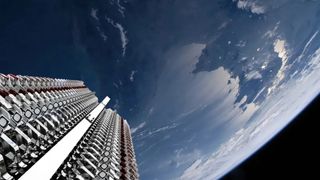
Starlink satellites before deployment.
(Image credit: SpaceX)
SpaceX’s Starlink fleet survived solar storms over the weekend.
Starlink broadband satellites, which number nearly 6,000 in orbit, all came through after intense solar activity sparked auroras and other signs of space weather across the world, including unusually far into the southern United States.
“All Starlink satellites on-orbit weathered the geomagnetic storm and remain healthy,” SpaceX officials wrote Sunday (May 12) on a statement on X, formerly known as Twitter.
That is no small milestone, given part of the fleet suffered an issue after a solar storm in 2022. The solar storms over the weekend caused other satellite issues unrelated to Starlink, however. The New York Times, for example, reported farming equipment being affected by GPS outages just as planting season reaches its peak.
Related: ‘Extreme’ solar storms cook up sweet Mother’s Day auroras for Moms everywhere
In February 2022, a Falcon 9 rocket launched 49 Starlink satellites. The next day, a geomagnetic storm increased the density of the atmosphere, unexpectedly increasing the drag force on the satellites. Most were doomed to fall back to Earth.
“Preliminary analysis show the increased drag at the low altitudes prevented the satellites from leaving safe mode to begin orbit-raising maneuvers, and up to 40 of the satellites will reenter or already have reentered the Earth’s atmosphere,” SpaceX wrote in an update at that time.
Breaking space news, the latest updates on rocket launches, skywatching events and more!
SpaceX just launched its latest batch of satellites on Sunday (May 12). It sent 23 more Starlink satellites to orbit from Florida’s Cape Canaveral Space Force Station. Those Starlinks appear to be doing fine so far; SpaceX previously said that better weather forecasts would be needed to protect the fleet from future solar storm incidents.
Sunday’s launch was already the 49th orbital mission of 2024 for SpaceX, with 33 of those launches devoted to Starlink. The constellation consists of about 5,900 working satellites.
Join our Space Forums to keep talking space on the latest missions, night sky and more! And if you have a news tip, correction or comment, let us know at: [email protected].
Elizabeth Howell (she/her), Ph.D., is a staff writer in the spaceflight channel since 2022 covering diversity, education and gaming as well. She was contributing writer for Space.com for 10 years before joining full-time. Elizabeth’s reporting includes multiple exclusives with the White House and Office of the Vice-President of the United States, an exclusive conversation with aspiring space tourist (and NSYNC bassist) Lance Bass, speaking several times with the International Space Station, witnessing five human spaceflight launches on two continents, flying parabolic, working inside a spacesuit, and participating in a simulated Mars mission. Her latest book, “Why Am I Taller?”, is co-written with astronaut Dave Williams. Elizabeth holds a Ph.D. and M.Sc. in Space Studies from the University of North Dakota, a Bachelor of Journalism from Canada’s Carleton University and a Bachelor of History from Canada’s Athabasca University. Elizabeth is also a post-secondary instructor in communications and science at several institutions since 2015; her experience includes developing and teaching an astronomy course at Canada’s Algonquin College (with Indigenous content as well) to more than 1,000 students since 2020. Elizabeth first got interested in space after watching the movie Apollo 13 in 1996, and still wants to be an astronaut someday. Mastodon: https://qoto.org/@howellspace
>>> Read full article>>>
Copyright for syndicated content belongs to the linked Source : Space.com – https://www.space.com/spacex-starlink-solar-storm-healthy-satellites






























